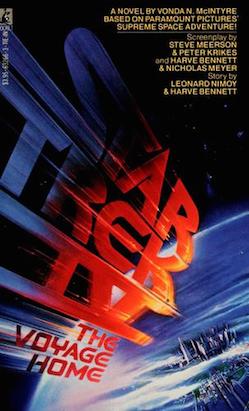For those of you who may have been busy (or not yet born) in 1986, Star Trek IV: The Voyage Home is the story where Kirk et al DON’T go where no man has gone before. Instead of doing their fantasy jobs, which they are amazing at, and living their fantasy lives, they do what everyone in 1986 did every day. They take on the challenges of navigating San Francisco during what turned out to be the twilight of the Cold War.
At its heart, The Voyage Home is a screwball comedy. It works by highlighting the strangeness in ordinary things. This is exactly the kind of story that Vonda McIntyre does well. Her depth of characterization enhances both the peril and the humor of a complicated plot that has to carry a series of hefty metaphors. The problems of a time when humanity threatened to destroy itself are a parallel to the 24th century threat of a probe threatening to destroy humanity.
The voyage referred to in the title is simultaneously the crew’s return to earth, their voyage into the past to find some whales who can answer the probe’s signal, and their struggle to restore the status quo that was interrupted by Spock’s death and re-birth in the last two films. Spock is voyaging into a better understanding of his relationships with Kirk and McCoy and his half-human nature.
It’s pretty heavy stuff. But Vonda McIntyre is here to save you.
The crew struggles in the 20th century—they have to manage money (their effort to save the whales has a $200 budget), make change, and deal with the shortcomings of 20th century society and medicine. McIntyre illustrates these challenges in a quirky vignette in which cetacean biologist Gillian Taylor takes Kirk out to dinner. Kirk desperately needs to charm Dr. Taylor, who has two juvenile humpback whales in a tank at her research institute. Unfortunately for Kirk’s plans, he’s not in a position to charm anyone. He’s using his best “diplomat on an unfamiliar planet” manners on someone who doesn’t realize how alien she is to him. He tries to explain that he’s from the future and can keep her whales safe. Kirk’s charisma isn’t enough to win Taylor over—he’s a weird guy who can’t pay for dinner. McIntyre illustrates the complexity of Kirk and Taylor’s differences with a simple description of Kirk eating a slice of pizza backwards.
Budgetary limitations are the only reason Kirk needs captive whales. It is relatively easy to see humpback whales in the wild, where they are generally tolerant of human divers. Kirk and co. might have been equally successful in their mission if they had chartered a boat and some scuba gear. Dr. Taylor’s whales would have been slaughtered by hunters if Kirk hadn’t arranged their rescue, but mature wild whales would have been able to sing the complex songs that the earth-threatening probe is looking for, back in the 24th century. McIntyre refuses to leave this plot hole unplugged. When the whales finally talk to the probe, they have to explain why they can’t speak properly and don’t know anything.
Although her whales aren’t strictly necessary to Kirk’s mission, Dr. Taylor herself is. In the original television series, Kirk’s masculinity was demonstrated by his charisma and his competence. Both are in question here. In the tradition of screwball comedy, the female protagonist drives the action. Taylor’s decision to give Kirk the information he needs to track her whales after their release from captivity comes with a price; She insists on travelling back to the future with them. The women Kirk charms usually remain in the planet or past where he found them. But Dr. Taylor is instrumental in helping the crew complete their mission. She doesn’t just provide a radio frequency for the whales’ satellite trackers—she helps the crew navigate the 20th century so they can return home, and provides expertise the 24th century needs to repopulate earth’s oceans with previously extinct whales.
The Enterprise crew saved the future and the whales by travelling back in time, finding a pair of captive whales, sending Spock to have a chat with them about their future, recharging their dilithium crystals using something I don’t even pretend to understand stolen from a nuclear submarine, building a tank on their captured Klingon ship, and beaming the whales into it before they can be killed by hunters (and before the glue holding the tank together is dry). This is a difficult and dangerous process—Chekov nearly dies, giving him a “nearly dead” average of 75% over the first four films.
Things have gotten better for whales since the film was made in the 1980s. While some populations remain at risk, there are now about 80,000 humpback whales worldwide. You can help their continued recovery through everyday activities like eating ethically sourced fish. Star Trek: Ethical Fisheries doesn’t instantly strike me as a gripping plot, but anything can happen in the alternate timeline.
Ellen Cheeseman-Meyer teaches history and reads a lot.










